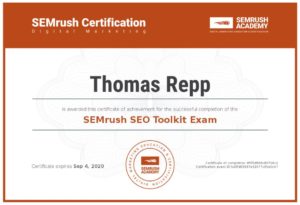 In today’s world for search, mobile, social and AI, what can a mid-size B2B industrial marketing department, with limited resources, do to remain competitive in their specific B2B industry?
In today’s world for search, mobile, social and AI, what can a mid-size B2B industrial marketing department, with limited resources, do to remain competitive in their specific B2B industry?
First, find some help. I just happen know someone you can call.
You have been too busy thinking about operations, personnel issues, new technology in your industry, meetings, etc. to even wade into the murky waters of online marketing.
Second, you must understand that in most B2B industrial markets, there is a huge opportunity to gain significant brand traction and visibility online because most mid-size industrials are simply not paying attention to online opportunities and tactics.
Given my 25 years of experience and the two factors outlined above I believe it is absolutely necessary for B2B industrials to embrace the web as their most prolific brand building and lead generation machine moving forward.
With the coming era of artificial intelligence, the following outline and tasks will lay a strong foundation for the disruptive changes in the search engines and the way they display answers and content to your buyers.
But…it takes patience, resources and time.
I can’t tell you how many times we have started an online strategy that was actually working, but the owners were impatient because they could not directly attribute large sales to online marketing efforts.
I understand, we all need to see ROI quickly.
But the online world simply does not always work that way.
However, to get your mid-size B2B industrial company moving in the right direction I have put together a basic outline of the things that you need to think about before embarking on a journey into online branding and lead generation. If nothing else, let this outline provide you with enough information so that you can effectively interview a potential marketing whiz or hire an online marketing agency that keeps up with this stuff.
- Understand Your Industrial Brand:
In my experience, most B2B’s have a great story to tell that has the potential to connect with your industrial buyers. However, most have not spent the energy to really tell their brand story well. If you are going to produce an online brand and lead generation machine, you must first start by telling your brand story well and weaving that brand story into all your marketing materials, online and offliine.
- Understand Your Industrial Buyer:
Conduct market research to understand your target audience's pain points, challenges, and needs. Create detailed buyer personas to help guide your marketing efforts. Yep, we know how to do that also.
- Optimize Your Website:
Ensure your website is user-friendly, mobile-responsive, and optimized for search engines (SEO). Create informative and engaging content. Start by creating a blog first (Google will love you for this), then case studies, and product information.
- Content Marketing:
Develop a content marketing plan that includes regular, high-quality content production. Create industry-specific blog posts, whitepapers, eBooks, and videos that showcase your expertise and address customer pain points. We recommend hiring a creative content specialist, possibly with a background in journalism and video production that understands the value of content and knows the importance of keeping the cadence of your published content at high levels.
- Email Marketing:
Once your web site reaches a decent brand visibility level, where 30 percent of your critical keywords or topics are in the top 3 positions of Google you can start thinking about email marketing. The biggest mistake B2B industrials make is they bulk/blast their emails as opposed to segmenting their emails. Segment your email list to send targeted, relevant content based on demographics, job title, company, web behavior, etc. Use email to nurture leads, provide product updates, and share industry insights. According to GlobalSpec & Trew Marketing's 2023 State of Marketing to Engineers, email marketing can still be the most effective lead generator … if you segment your contacts and emails properly.
- Search Engine Marketing (SEM):
Once you get some traction from your email marketing, depending on your specific industry, you might run pay-per-click (PPC) campaigns on platforms like LinkedIn Ads to target specific keywords and drive traffic to your website. Make sure you consult with a known specialist before you spend money for online advertising.
- Search Engine Optimization (SEO):
Optimize your website and content to rank well in search engine results for relevant keywords. Regularly update and improve your content to maintain strong SEO performance. Content that you published years ago that is still relevant should be updated once a year with fresh content, graphics, data, etc. Google will love you for it.
- Social Media Marketing:
Determine the social media platforms most relevant to your industry. For the mid-size B2B market, I highly recommend just starting with LinkedIn. For a bunch of reasons (mostly a lack of your marketing resources), I think social media is a waste of resources for mid-size B2B industrial market. Again, having some outside help to get you started pays big dividends.
Share industry news, engage with your audience, and showcase your company's culture and expertise.
- Account-Based Marketing (ABM):
Identify key target accounts and create personalized marketing campaigns to engage with decision-makers. Use ABM tactics, like personalized content and outreach, to build strong relationships. HINT: Using marketing automation platforms like HubSpot makes these tasks a piece of cake.
- Webinars and Virtual Events:
Host webinars or virtual events to showcase your thought leadership and engage with potential clients. These can be valuable for educating prospects and demonstrating your product's capabilities.
- Analytics and Data-Driven Decisions:
By implementing a marketing automation platform, you can use advanced analytics tools to track the performance of your online marketing efforts. Regularly review data to make informed decisions and optimize your strategies.
- Customer Relationship Management (CRM):
If you implement a good marketing automation platform, most have advanced CRM modules. Many are free to start. Use a CRM system to manage leads, track interactions, and nurture relationships with potential and existing customers.
- Influencer Marketing:
Partner with industry influencers who can vouch for your products or services. Influencers can help you reach a broader audience and build credibility.
- Paid Social Advertising:
Consider paid social advertising on platforms like LinkedIn to target specific B2B audiences. LinkedIn’s ability to target our buyer’s persona and demographics is amazing and well worth it. No other social media has this capability for the mid-size B2B industrial market.
- Competitor Analysis:
Continuously monitor your competitors' online marketing strategies and adapt your own to stay competitive. Using marketing research platforms such as SEMrush can provide you with some amazing insights into your competitors’ online marketing strategies making all your online tactics more effective putting your company ahead of your competitors on the search engine return page.
Marketers always get excited about Google Analytics. GA is great, but it only provides data for your own website. When I work with a client I want to know how our efforts compare to my client's closest competitors. That is the only way to gain a competitive advantage online the main reason we rely on SEMrush.com.
- Customer Reviews and Testimonials:
Encourage satisfied customers to leave reviews and testimonials on your website and third-party review sites. I have had success with a simple handout given to satisfied customers to encourage them go online and write a quick Google review.
- Referral and Affiliate Marketing:
Implement a referral program to incentivize existing customers or partners to refer new business to your company. Again, a simple handout to a satisfied customer that encourages them to provide a referral with a small incentive works great.
- Community Building:
Foster a community around your brand, whether it's through forums, social media groups, or industry-specific events.
- Experiment and Adapt:
Don't be afraid to experiment with new marketing tactics and technologies. Continuously adapt your strategy based on the evolving needs of your target audience and industry. Again, marketing automation makes these marketing tactics relatively easy. Also, with marketing automation it is easy to see what works and what does not work (Just like your accounting software keeps track of your financial assets, marketing automation keeps track of all your marketing assets). Double down on the tactics that work.
- Compliance and Data Security:
Ensure that your online marketing strategies comply with industry regulations, especially when handling customer data. Ensure your servers are all up to date to keep the hackers away. Be especially careful of your WordPress sites. The popularity of WordPress has the unfortunate side effect of providing a rich environment for bad actors.
- Measuring ROI:
Establish clear metrics to measure the return on investment (ROI) of your online marketing efforts, and adjust your strategy based on the results.
I like to start with a KPI (Key Performance Metric) called Brand Visibility Percentage.
By starting with a KPI of Brand Visibility Percentage you will ensure that your online strategy and content is future proof. Focusing on Brand Visibility Percentage guarantees the following:
- Your content is well done and targeted to the right buyers ... content your buyers need and want.
- Your website is structured in such a way that makes it easy for the search engines to index. Chances are your competitors' websites are not structured properly.
- Your website is optimized for voice recognition.
- Focusing on the KPI of Brand Visibility Percentage guarantees that the heart of your strategy is best SEO practices. This fact alone ensures your content is ready for new search engines that use artificial intelligence to display an accurate and quick answer rather than a list of web pages your buyer hates to peruse through.
All other KPIs such as conversion rates, etc. can follow once your brand presence has been established in your industry.
Remember that the success of your online marketing strategy will depend on your ability to align it with your specific industry, target audience, and business goals. Regularly evaluate your efforts, adjust your strategy as needed, and stay up to date with the latest digital marketing trends and technologies. And do not forget your patience!
This is a marathon, not a sprint.
Author:Tom Repp
A passionate marketer attempting to change the way industrial marketers leverage the web as a growth-oriented, lead generation machine. View all posts by Tom Repp






